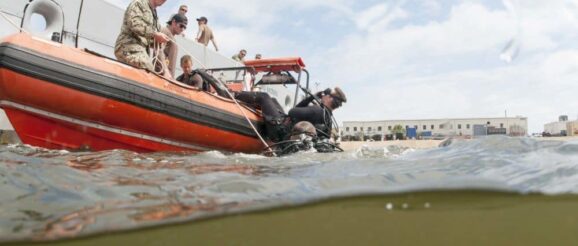Navy’s dirt sailors operate at the cutting edge, both of innovation and of risk


They’re called the Navy’s dirt sailors — but the 20,000 men and women of the Little Creek-based Navy Expeditionary Combat Command get into some high-tech challenges in their small detachments, posted around the world.
Some are working with second-generation drones — and for some that means working underwater with them, while for some, it has meant parachuting from a plane, with a drone in hand, to disarm a bomb or mine. One, command sailor Petty Officer 3rd Class Christopher Rector, was part of the Navy team that designed a new kind of quick-to-build ventilator for COVID-19 patients.
There’s plenty of history to the group, too — at least as new C.O., Rear Adm. Joseph A. DiGuardo Jr., figures it.
It was, after all, the fisherman and merchant mariners of the Marblehead, Mass., militia who ferried the raiding parties that disrupted British supply lines before bringing George Washington and the rest of his army across the Delaware River to win the Battle of Trenton, DiGuardo said.
Like the sailors in his command, the Marblehead militiamen bridged a gap between the water and land, DiGuardo said.
That’s what the expeditionary command’s Seabees — Naval Construction Forces — do when they land on a hostile shore to build the piers and on-shore infrastructure needed to support American troops.
So do the command’s sailor-stevedores, including Cheatham Annex-based Navy Cargo Handling Battalions 1 and 10.
Their job “is to make sure pilots don’t go winchester — run out of ammunition — Marines don’t run out of bullets and sailors don’t run out of food,” as DiGuardo put it.
Bridging the gap is the mission of the command’s Maritime Expeditionary Security Force, whether its sailors are on one of the 34-foot patrol boats, protecting warships in hostile ports or stationed on a Navy supply ship to fend off the pirates who still haunt some waters.
That’s not too far from the mission of the command’s explosive ordnance technicians, when they clear mines — sometimes in harbors, sometimes in deep blue waters and sometimes even on land.
Navy divers are in the expeditionary command, as well, since they work closely with Seabees and explosive ordnance techs. An exercise the Little Creek-based divers of Mobile Diving and Salvage Unit 2 did earlier this year, training with explosive disposal techs from Rhode Island on a scenario that simulated a mine striking a ship. The scenario demanded an underwater search for any other mines, underwater repair and safely unloading ordnance from a damaged warship.
“Think of it as: clear, secure, build, protect,” DiGuardo said.
The work of the command’s sailors comes down to clearing away hazards, securing an area for others to operate, building the things needed to support military operations and protecting themselves and the tasks they are charged with from attack, he adds.
All have share the risk-reading insight, judgment and combat skills needed to know how to protect themselves and their fellow sailors on hostile ground, when danger is close-in — and how to tell when the unfamiliar is simply unfamiliar and not a threat.
They also share this: expeditionary sailors often operate in small groups, in what DiGuardo diplomatically describes as “austere” locations.
That’s the Navy way of saying many things, even basics like easy communications, can be hard to find for expeditionary command sailors on deployment.
“They have to be self-reliant, real leaders,” DiGuardo said.. “They have to learn to be flexible, but how not to be so flexible that they can’t do the job the right way.
___
(c) 2020 the Daily Press
Distributed by Tribune Content Agency, LLC.
